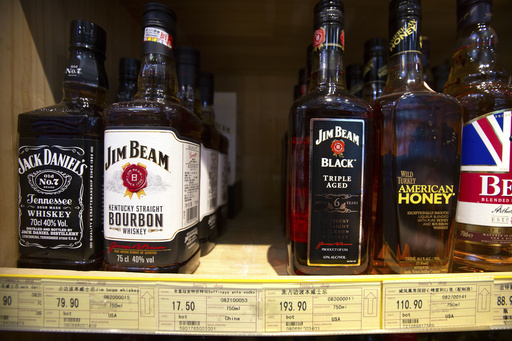
LOUISVILLE, Ky. — The American whiskey market is facing significant challenges in 2024, with domestic sales proving disappointing largely due to inflation impacting consumer purchasing behaviors for various spirits. On top of this, looming tariffs pose a serious threat to sales in important international markets, according to a report released by an industry group.
Ongoing trade disputes with nations like Canada and Mexico are likely to inflate prices for U.S. spirits in these regions. However, the most significant threat arises from the European Union, where tariffs are set to reemerge on April 1, doubling the rate against American whiskey makers. This situation places producers back into a contentious trade issue centered around steel and aluminum. The Distilled Spirits Council highlighted that these tariffs could reverse the positive sales trend observed in Europe since the suspension of a previous 25% tariff several years ago.
Chris Swonger, CEO of the Distilled Spirits Council, emphasized the devastating impact reestablishing these tariffs could have, especially in the European market. “Implementing tariffs at a 50% rate would devastate this growth and cause irreparable harm to distillers, both large and small,” Swonger stated. He warned that such a move could lead to significant losses for distillers who heavily rely on European markets for exports.
The council’s recent findings on U.S. spirits sales also reflected a downturn in the domestic whiskey sector, which encompasses bourbon, Tennessee whiskey, and rye whiskey. Unfortunately, specific sales figures for each whiskey type were not disclosed.
As the administration under President Trump aims to reshape global trade policies, the spirits industry has become a prominent target for retaliatory measures. During earlier trade negotiations in Trump’s first term, American whiskey exports to the EU suffered a substantial 20% decline. Conversely, once the tariffs were lifted, exports rebounded sharply by 60%, illustrating the volatility of the industry in response to trade disputes.
In Canada, another crucial export market, initial tariffs on American goods included spirits until a recent reprieve was announced. Prior to this hold, several provinces had considered removing U.S.-made liquors from government-operated stores.
Trump views these import taxes as leverage for gaining concessions on issues ranging from immigration to raising revenue for government budgets. However, this strategy has raised concerns among whiskey producers and their advocates, especially in states that largely backed Trump, like Kentucky, the home of 95% of the world’s bourbon. Data from the Kentucky Distillers’ Association indicated that a record 14.3 million barrels of bourbon were in aging warehouses as 2024 began.
The resurgent threats of tariffs hit as Boundary Oak Distillery in central Kentucky aims to penetrate the EU market and supplement its sales across 12 to 15 states in America. Owner Brent Goodin expressed the distillery’s commitment, noting, “We’re trying very hard to make a presence. Craft products, especially craft bourbons, are appreciated all over the world.”
Goodin stated that his distillery successfully shipped approximately 200 cases of bourbon and lavender whiskey to Lithuania last fall, with plans for future sends, including new markets like Poland and Hungary. However, he expressed concern over the possible repercussions of the 50% tax. “That would wipe out the market,” he remarked. “That would pretty much kill it.”
The spirits industry, which encompasses exports from all 45 states, sees American whiskeys making up an impressive 63% of total U.S. spirits exports. The council hopes for a more favorable trade environment to prevent their products from getting embroiled in unrelated trade arguments. Swonger remarked, “This industry should not be involved in unrelated trade disputes.”
Domestically, U.S. spirits producers are facing additional hurdles. Despite maintaining their market share, revenues for the spirits industry experienced a decline in 2024. Specifically, supplier sales dropped by 1.1%, totaling $37.2 billion, even as volumes increased slightly by 1.1% to 312.2 million 9-liter cases.
Revenue and volumes for high-end spirits, which attract premium pricing, fell last year. As inflation continues to pinch consumers, many have turned to cheaper alternatives. Swonger pointed out that a combination of rising costs and high interest rates prompted customers to reduce their spending on what are often considered luxury items, like distilled spirits.
After a spike in sales caused by the pandemic, the overall results for the spirits industry seem to reflect a stabilization to pre-COVID levels. Additionally, trends suggest that younger consumers are drinking less. The council noted that domestic sales of American whiskeys saw a 1.8% drop in 2024, amounting to $5.2 billion in revenue.
On another note, vodka sales remained stable at $7.2 billion, while tequila and mezcal sales experienced a 2.9% uplift, totaling $6.7 billion. Notably, sales of ready-to-drink cocktails surged impressively by 16.5% to reach $3.3 billion, demonstrating shifting consumer preferences in the spirits market.

